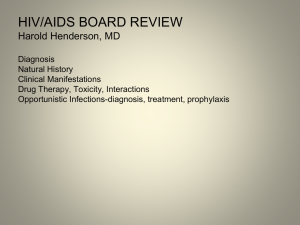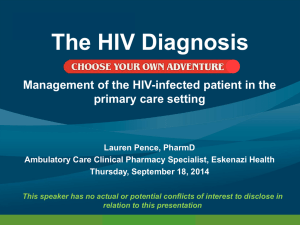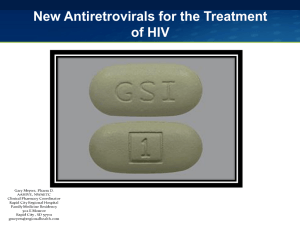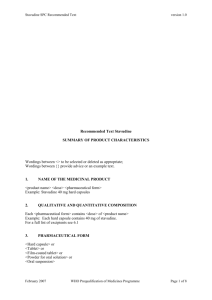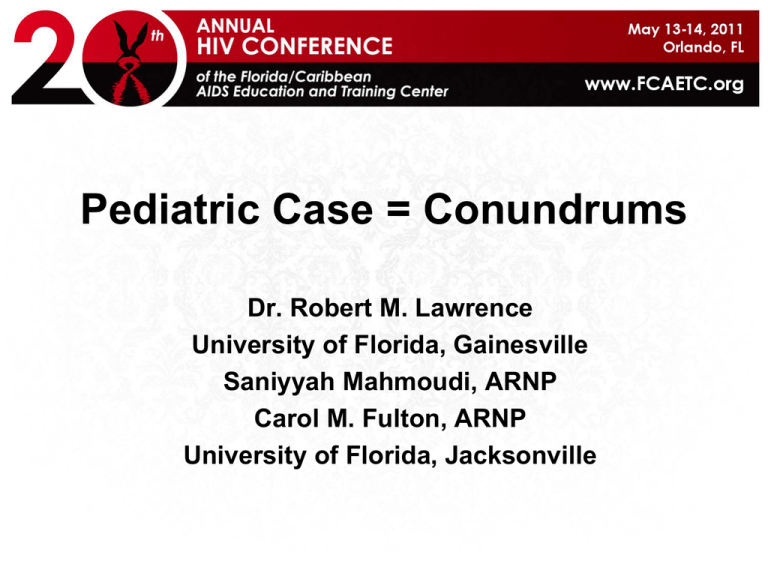
Pediatric Case = Conundrums
Dr. Robert M. Lawrence
University of Florida, Gainesville
Saniyyah Mahmoudi, ARNP
Carol M. Fulton, ARNP
University of Florida, Jacksonville
Disclosure of Financial Relationships
The speakers have no significant financial relationships with
commercial entities to disclose.
This slide set has been peer-reviewed to ensure that there are
no conflicts of interest represented in the presentation.
Objectives
• Present in a case-based discussion format
–unique scenarios which highlight
interesting concepts in Pediatric HIV care
• Utilization of Post-exposure Prophylaxis
(PEP)
• Acute HIV Infection in a teenager
• Rheumatologic complications of HIV
disease
Case #1
• A 10 year African-American female with perinatal
HIV infection
• On Epivir, Stavudine and Lopinavir/r for three +
years.
• Viral load has been <50 for 3 years
• CD4 counts are stable @ 29-39% (765-1259)
• CDC Classification B3 – recurrent bacterial
infections and CD4 % < 15% repeatedly @ 4 years
of age
• History of peripheral neuropathy – improved on
Vitamin B6 50mg daily
Case #1
• !0 yo AA female present to the ER with pain in
her left foot and left buttocks / hip without
fever, gait reported as normal
• Urinalysis shows + leukocyte esterase, 10
WBCs, 5 RBCs (subsequent culture + for
Enterococcus >100,000 cfus)
• Positive Family History for “Rheumatoid
Arthritis in the Paternal Grandmother
• Recent VL <50, CD4 28%, 966
• Given Septra for UTI, and hydrocodone for
hip pain
What is the most likely diagnosis
at this time?
1. HIV-associated
arthralgia / myalgia
2. Reactive Arthritis
3. Septic arthritis /
osteomyelitis
4. Systemic Lupus
Erythematosis
Rheumatologic Manifestations
of HIV Infection
Common Disorders
•
•
•
•
•
•
•
HIV assoc. arthralgia/myalgia
Reactive arthritis
Psoriatic arthritis
Vasculitis
Polymyositis
Pyomyositis
Septic arthritis/osteomyelitis
• Zidovudine myositis
Less Common Disorders
• Avascular necrosis
• Rhabdomyolysis
• Diffuse infiltrative
lymphocytosis syndrome
(DILS)
• Rheumatoid arthritis
• Systemic lupus
erythematosis
• Sarcoidosis
Reveille JD, Best Pract & Res Clin Rheumatology 20:1159-79, 2006
Colmenga I, Curr Opinion Rheumatology 18:88-95, 2006
Case #1
• This 10 year old AA female returns 6 weeks later complaining of
different joint pains, especially the left knee > right knee, no
dysuria, no fevers, a 3 pound weight loss, and occasional loose
stools
• She has a red, warm, swollen left knee > the simply swollen right
knee and decreased ROM of wrists and ankles due to pain not
weakness (no “arthritis”)
• Rapid Strept throat swab + culture, urinalysis and culture, stool
cultures, Urine for GC/CZ, ASO, PCR for CMV, EBV, HBV, HCV,
HTLV-I and Parvovirus, along with a Rheumatologic panel and
routine HIV labs are sent
• Patient is given Naprosyn 375 mg PO BID, Prevacid for
symptomatic treatment
Arthritis of Left Knee
What is the most likely diagnosis
at this time?
1. Rheumatic Fever
2. Reactive Arthritis
3. HIV associated
Arthritis
4. Rheumatoid Arthritis
5. Systemic Lupus
Erythematosis
Case #1
• All the “reactive arthritis” labs are negative.
• Her VL is <50 and CD4 counts are stable.
• The ANA is positive 1:1280. The RNP, SSA and SSB, Smith Ab,
Anti-phospholipid Ab and Histone Ab are all positive with normal
C3 and C4 levels.
• The tentative diagnosis is drug mediated autoimmune antibody
response (Kaletra). Pt. continues on Prevacid, Indocin, and ASA
with symptomatic relief.
• Her ARVs are changed based on Genotype testing and she
intermittently has VL < 50 due to poor compliance.
• She is followed by the Rheumatology and ID services.
Case #1
• 18 months later this 12 yo female develops hematuria and
proteinuria along with very low C3 and C4 levels and “re-elevation”
of her autoimmune antibodies (ANA again 1:1280)
• A renal biopsy shows diffuse proliferative immune complex (IgG,
IgM, C3 and C1q) glomerulonephritis, most consistent with lupus
nephritis, Class IV-G.
Mialou V et al. Lupus Nephritis in a Child with AIDS. Am J Kid Dis 37:E27, 2001
Palacios R et al. HIV infect and SLE. Lupus 11:60, 2002
Chang BG et al. Renal Manifestations of Concurrent SLE and HIV. Am J Kid Dis 33:441,1999
Haas M et al. HIV-associated IC glomerulonephritis with “lupus-like” Kidney Int 67:1381,2005
Chalom EC et al. Pediatric Pt. with SLE and congenital AIDS. Ped Rheum 6:7, 2008
Sacilooto NC et al. Juvenile SLE in a adolescent with AIDS Rev Bras Rheum 50:467, 2010
Case #1
• This patient is now almost 16 years old with
reasonable control of her Lupus nephritis and
arthritis with monthly infusions of corticosteroids
and cytoxan.
• Her medical care has been complicated by the
separation and divorce of her parents.
• Her HIV is poorly controlled due to noncompliance with her ARV regimen.
Lupus Nephritis
WHO Class IV-G
Case #1
Take Home Points
• Musculoskeletal disease in association with HIV
is more common.
• Rheumatologic disease is also more common.
• Effective ARV therapy / control is an important
aspect of therapy for these patients.
• Corticosteroids is the mainstay of therapy in
most rheumatologic disease with HIV
• Cytotoxic agents can be used in refractory cases,
with CD4 counts > 200.
Case #2
• 17 yo WM presents to the ER with fevers, decreased
energy and whole body aches for 2 weeks, diarrhea and
3 lb. weight loss in the last week, arthalgia in lower
extremities, a new rash on hands and feet
• Patient reports unprotected receptive anal intercourse
• The patient has a 1.5 cm “painless” ulcer on the corona
of his penis. Temperature is 38.8 C. Both knees are
swollen , warm but not red. His tonsils are 2+ without
exudate or other oral lesions noted. There are multiple,
bilateral 1-2cm. anterior cervical nodes which are mildly
tender and non-tender 1 cm. inguinal LNs. His palms
and soles have multiple 0.5-1 cm. red macules.
• His neurological exam is entirely normal.
What is the most likely
diagnosis?
1.
2.
3.
4.
5.
Syphilis
Chancroid (H.ducreyi)
LGV ( C. trachomatis)
Syphilis and GC
Syphilis and HIV
Clinical Picture of Primary HIV Infection
•
•
•
•
•
•
•
•
•
Fever
Lethargy
Myalgia
Headache
Sore throat
Inflammed throat
Coated tongue
Enlarged tonsils
Cervical LNs
• Axillary LNs
• LNs at > 2 sites
20
12
8
8
19
17
10
9
19
•
•
•
•
•
•
•
•
•
Rash
Genital ulcer
Anal ulcer
Vomiting
Nausea
Diarrhea
Weight loss > 5 kg
Total # patients
Incubation 11-28 days
15
2
2
8
7
6
4
20
15
11
Gaines et al. BMJ 297:1363, 1988.
Exposure Risk
(average, per episode, involving HIV-infected source)
Exposure
Risk
Percutaneous (blood)
0.3%
Mucocutaneous (blood)
0.09%
Receptive anal intercourse
1%
Insertive anal intercourse
0.06%
Receptive vaginal intercourse 0.1 – 0.2%
Insertive vaginal intercourse
0.03 – 0.14%
Receptive oral sex with a
male
0.06%
Female – female orogenital
contact
(only 4 case reports)
IDU – needle sharing
0.67%
Perinatal (no prophylaxis)
24%
Verghese B et al. STD 2002;29:38-43. European Study Group BMJ 1992;304:809.
Macaluso JM et al. STD 1999;26:450-8.
Should you do an LP on this
patient looking for Neurosyphilis?
1. Yes
2. No
3. Abstain
HIV and Syphilis
Is the LP indicated?
CDC Guidelines
•
•
•
•
•
Neurologic or ophthalmic signs
or symptoms
Evidence of active tertiary
syphilis (aortitis, gumma or iritis)
Treatment failure
HIV infection with late latent
syphilis or syphilis of unknown
duration
CDCP 2002 MMWR 51: 18-30
Other Criteria?
• 65 patients with neuorsyphilis
and had LP
• 50/65 co-infected with HIV
• Plasma RPR >/=1:32 -- ~6x
increased risk of neurosyphilis
• CD4+ count </= 350 cells -- 3x
increased risk
• Both parameters ~ 18x risk
• Marra CM 2004 JID 189:369
Case #2
Additional evaluation:
•
•
•
•
•
•
•
No fluid in knees
No other joints involved
No penile discharge or “milkable
discharge”
No petechiae
No epididymitis, proctitis or anal
lesions
No iritis or uveitis
No known drug allergies
Preliminary labs:
•
•
•
•
•
•
•
•
BMP – WNL
LFTs – WNL, except Tot. protein
= 8.2g/dL
WBC 6400 (69P/19L/7M/5E)
Hgb =12.4 and Hct = 35.9
Platelets 268,000
Monospot negative
Rapid Strep Test negative
Rapid HIV1/2, Ab + Ag positive
Empiric STI Treatment with
what?
1. Rochephin and
Azithromycin
2. Wait for test results
3. Rochephin and
Doxycycline
4. Rochephin,
Azithromycin and
Penicillin
Case #2 – One Week Later
Signs and Symptoms
Follow-up labs
• Fevers, poor appetite
• Thin and pale
• Knees and ankle pain with
early morning stiffness
• Weight loss 6 kg in 1 week
• No vomiting or diarrhea
• Penile lesion – flat
hypopigmentation
• Rash – only peeling of palms
and soles
• Diffuse lymphadenopathy
•
•
•
•
RPR 1:64, TPHA +
HIV WB positive
HIV RNA PCR = 240,000
GC cultures of urethra, rectum
and throat all negative
• Urine GC / CZ NA are negative
• HIV Genotype pending
• No lymphocyte subsets
What would you like to do
now?
1. Lumbar puncture
and repeat
Penicillin
2. Repeat Penicillin,
discuss HIV
3. Recommend ARV
Therapy
4. Refer to GI
Case #2 Ongoing Care - 8 weeks
Treatment
• Completed three weekly
IM injections of
Benzathine PCN 2.4
million units
• Omperazole daily
• Naprosyn 500mg PO
BID
• Nu-iron 150 mg PO BID
• MVI one tab PO BID
Response
• No fevers, rashes
• 5 kg weight gain
• Only occasional joint
pain or morning
stiffness / no arthritis
• HLA B 27 positive
• RPR 1:16
• Hgb 11.2 / Hct 33.8
Case #2
Time
CD4 Total
(%)
Viral Load
Other
0
--
240,000
HIV Ag +, WB +
6 weeks
359 (17%)
395,430
ARV naive
13 weeks
221 (14%)
193,887
Genotype - pansensitive
18 weeks
249 (16%)
104,000
30 weeks
191 (18%)
123,000
44 weeks
396 (22%)
66
Atripla started
Aggarwal M. Acute HIV Syndrome in an Adolescent. Peds 2003; 112:e323.
Bell SK. Case 11-2009: Case Records of MGH. NEJM 2009; 360:1540.
Case no. 3
• 17 yo male with perinatal HIV infection
• Past history significant for BOM with
effusion
• No recent hospitalizations
• Immunizations UTD
• Lives with dad who is the primary caregiver
• h/o non compliance
Date
Medications
CD4
(absolute)
Viral load
1/25/94-10/31/95
Zidovudine
10/31/95-3/18/97
Zidovudine, Didanosine
3/18/97-7/15/97
Zidovudine, Lamivudine,
Ritonavir (ACTG 338)
1/1/98-8/18/98
Nelfinavir,
Zidovudine, Epivir
8/18/98-1/5/99
Zidovudine, Epivir,
Amprenavir (GSK 141study)
1/5/99-12/28/99
Stavudine,Didanosine,
Amprenavir (GSK 141study)
12/28/99-2/25/03
Stavudine, Epivir, Efavirenz
174-401
2,439-10,965
2/25/03-6/24/03
Didanosine, Stavudine,
Lopinavir/r
401-357
10,965-5,578
6/24/03-2/28/06
Abacavir + Didanosine +
Stavudine + Lopinavir/r
357-316
(132)
5,578 - <400
(117,000)
3/14/06-6/4/08
Epzicom + Lopinavir/r +
Stavudine
183-329
12,400-1,580
8/1/08-9/27/10
Truvada + Norvir + Atazanavir
141-29
5520-9730
490,641
HIV
GenoSURE
07/11/2006
Epzicom,
Stavudine,
Lopinavir/r
TRUGENE
HIV-1
7/11/2007
Epzicom,
Stavudine,
Lopinavir/r
Phenotype
6/7/09
Truvada,
Atazanavir/r
TRUGENE
HIV-1
5/4/2009
Truvada,
Atazanavir/r
TRU GENE
HIV-1
7/26/10
Truvada,
Atazanavir/r
Mutations
• RT mutations- 184V, T215Y/D, A62V
• PI mutations: L10I, M36I/V, I54M, D60E, L63,
A71T, V77I, L90M
Mutation Interpretation
• PI Major Resistance Mutations: I54M,
L90M PI
• Minor Resistance Mutations: L10I, A71T
Other Mutations: M36IV, D60E, L63P, V77I
Mutation Interpretation
• NRTI Resistance Mutations: A62DV,
M184V, T215DY
• NNRTI Resistance Mutations: None
• Other Mutations: None
Mutation Interpretation
• M184V/I cause high-level in vitro resistance to 3TC and FTC
and low-level in vitro resistance to ddI and ABC. M184V/I
increases susceptibility to AZT, TDF, and d4T.
• T215Y causes AZT and D4T resistance and reduces
susceptibility to ABC, ddI, and TDF particularly when it
occurs in combination with M41L and L210W.
• T215S/C/D/E/I/V are transitions between wild type and the
mutations Y and F.
• Other A62V is associated with multinucleoside resistance
caused by Q151M; its effect in the absence of Q151M is not
known.
What is the next best step? He wants to take
medications but is tired of taking so many
pills
1. Take him off all HAART
and start OI
prophylaxis
2. Take him off all
HAART, start OI
prophylaxis, start 3TC
3. Start new regimen
4. Adherence counseling
What regimen options would you
choose?
1. Atripla® (efavirenz/tenofovir/
emtricitabine) + Raltegravir
2. Darunavir/r + Truvada®
(emtricitabine/tenofovir) +
etravirine or raltegravir
3. Tipranavir/r + Truvada ®
(emtricitabine/tenofovir) +
etravirine or raltegravir
4. Send tropism assay for
maraviroc
Current regimen
• Atripla® (efavirenz/tenofovir/emtricitabine),
raltegravir (CD4 at start-29)
• Continued dapsone/azithromycin
• One month and 3 months later: CD4 29 to
95 (10%), VL remains undetectable
Case # 4
• 20 yo with perinatal HIV infection
• Highly treatment experienced
• Currently on darunavir/r, raltegravir,
emtricitabine/tenofovir, azithromycin, fluconazole,
dapsone
• Remains noncompliant last VL >100,000,
CD4 8 (1%) March of 2011
• Ongoing issues: wasting (wt down to 94 lbs),
diarrhea, candida esophagitis, pneumonia
12/2009-11
pt was on
atazanavir/r,
raltegravir ,
emtricitabine/
tenofovir
1/2009-10 pt was
on atazanavir/r,
raltegravir,
emtricitabine/
tenofovir
Date
Medications
CD4
Viral load
(absolute)
Mid 1999
Mutations
70R, 67N, 98G
103N ,219Q
2001 11yo
Zidovudine, Lamivudine,
Abacavir, Nelfinavir
2003 13 yo
Didanosine, tenofovir,
lopinavir/ritonavir
184V
2006 16yo
315 (20%)
308,000
2007 17yo
189 (15%)
>750,000
22 (3%)
461,000
2/2009
95 (8%)
570
4/2009
44 (5%)
1,690,000
R41K, 164V
6/2010 to
10/2010
48 (7%)
6 (1%)
72,700
325,000
M36I
HAART stop
3/2011
8 (1%)
>100,000
11/2008 19yo
Atazanavir/ritonavir,
emtricitabine/tenofovir,
raltegravir
What would you do next?
1. Take off HAART and
continue OI
prophylaxis only
2. Stress adherence and
continue current
HAART
3. Construct a new
regimen
4. Take off HAART and
start Epivir + OI
prophylaxis








